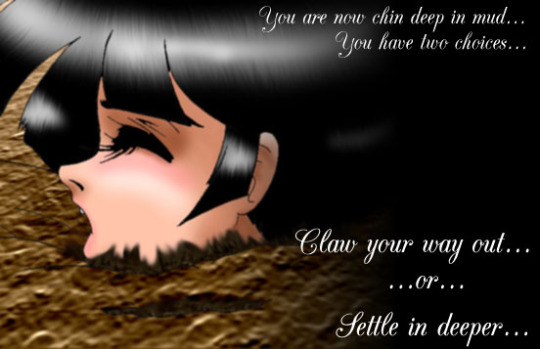#geocities soho
Text



Unicorn graphics, from /SoHo/Square/3304/ on Geocities.
#geocities#old web#webcore#unicorn#horse#animals#banner#dividers#fantasy#1990s#1999#SoHo#SoHo/Square
295 notes
·
View notes
Text
CelebArt 🖼
Hello everyone, the old page of the day is CelebArt from 1997. What caught my attention on this site, is that it was created by a 15 year old teenager using photo effects and filters that are so common today, but back in the day it was really a new world to be discovered. It just reminded me of myself when I was 12, and I figured out how to put an orange light effect on my hand in a photo, and I thought it was so cool because it looked like I was manipulating fire and so I showed this to everyone I knew, I was very proud of my "art". So let's take a look in her "arts".
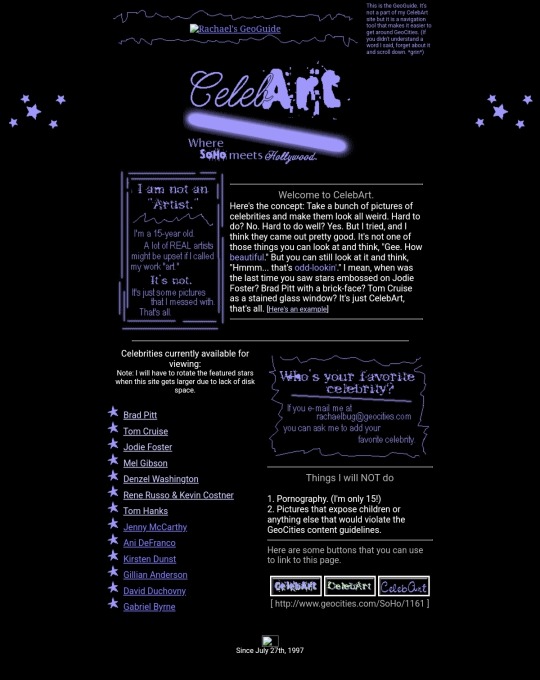
The first is her beloved one, Brad Pitt, like all the teenagers around me had him or other celebrities as a crush minus the weirdo here lmao.

I really find funny how this effects for us is so simple but for her it made Tom Cruise "sooo ugly" lol.
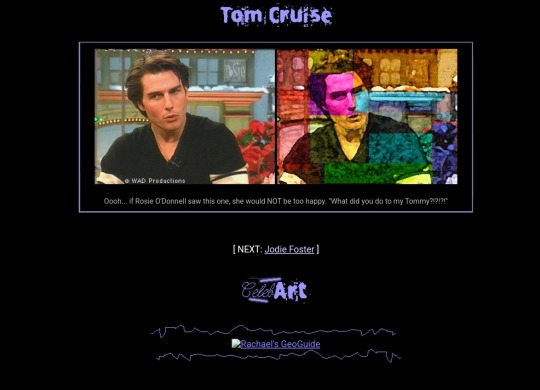
Oh she was nice to Jodie Foster and ended up putting just some stars in her face, unlike what she did to her beloved Brad Pitt.

Yeah, I really hope this person nowadays knows how to use the filters in Instagram and Snapchat to put any effects that she want in the face of Mel Gibson and any other person.

Ok in this one, I tryed to reload the page but there it's a bug in the original photo of Denzel Washington but afterwall this is a site from 1997 hosted in the Soho of Geocities, so it's a miracle we are seeing this page.

Also I really appreciatte that she took her time to explain and write something about these celebrities, like this page about Rene Russo and Kevin Costner.
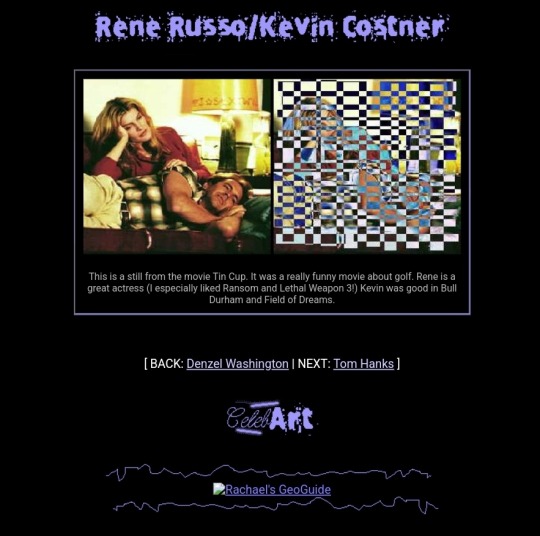
I didn't finded what programs she used to do all of this but I really imagining her have a fun time doing this with Tom Hanks.
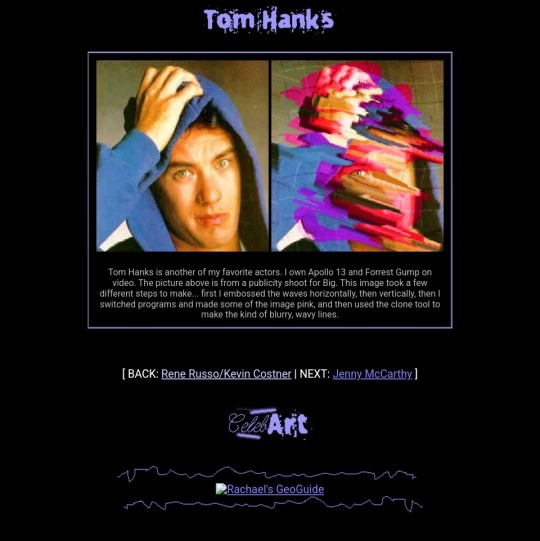
Now I want to know, what Jenny McCarthy did to you Rachael? Why you hate her so much?
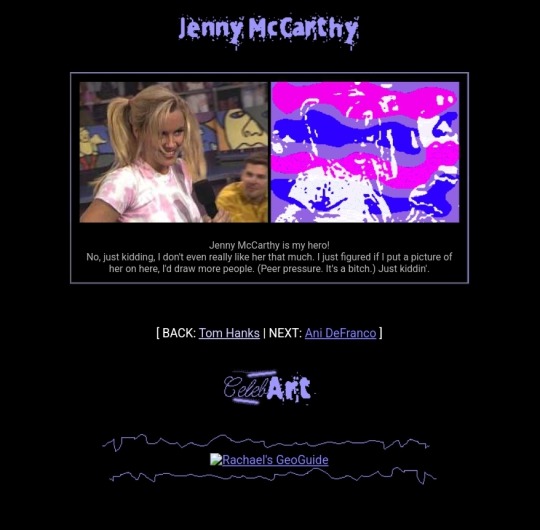
Our tallentousy artist even receive a requested to put some effects in this picture of Ani DiFranco.

Others celebrities that she put some effects was Kirsten Dunst...

...Gillian Anderson...
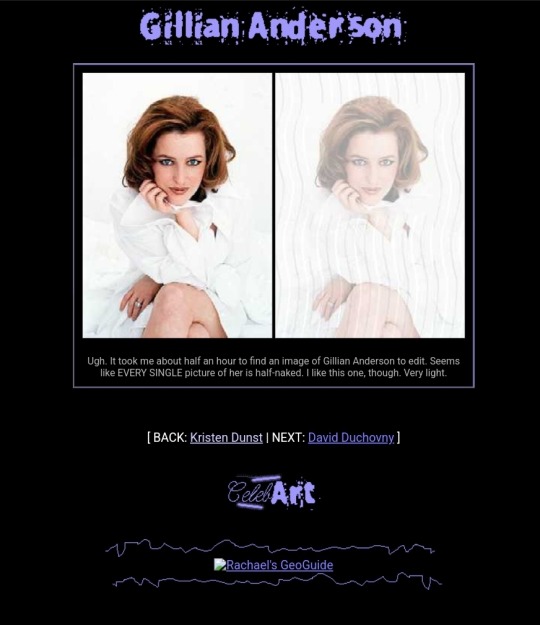
...David Duchovny... yeah guys we need to remember that she made this in 97...

...and Gabriel Byrne that was also requested. And yes, I tried to enter in the pages of these people that requested but they no more exist along with others links that were in the inicial page of CelebArt.
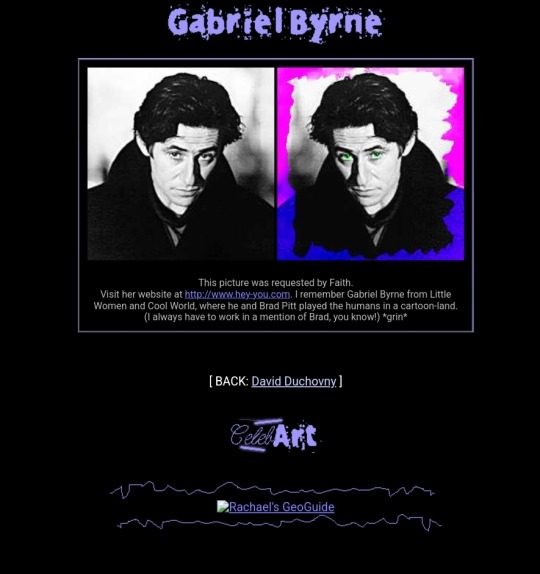
That's it. I find really funny how she put like a simple effect of bricks in the photo and then was like "ooooooh myyy gooosh" because I did exactly this to with my photos and this bring back good memories of a time that won't come back, the time that tecnology was new and could impressed us all in the good way. If someone wanna visit this site, here it is the link: https://geocities.restorativland.org/SoHo/1161/index.html#example
~ The Archeologist
#old internet#old web#old tech#webcore#internetcore#techcore#archives#old page#celebart#vintage 90s#90s vibes#retro#nostalgia#geocities#nostalgiacore
5 notes
·
View notes
Photo
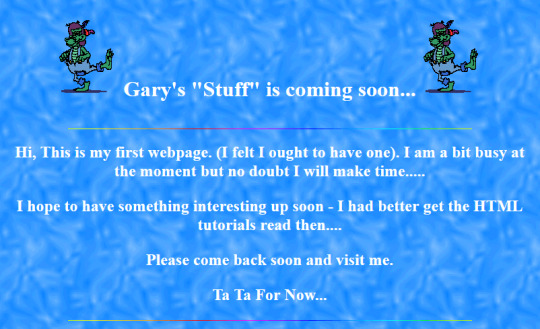
9 notes
·
View notes
Photo

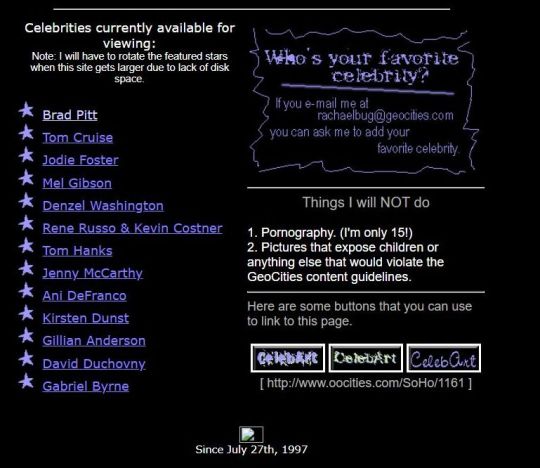


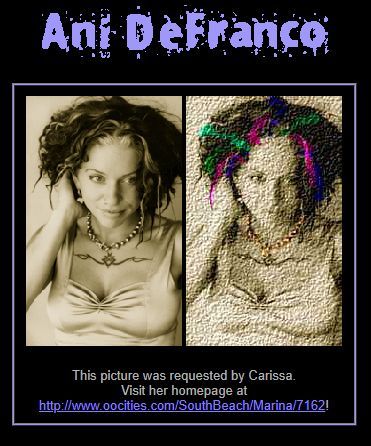



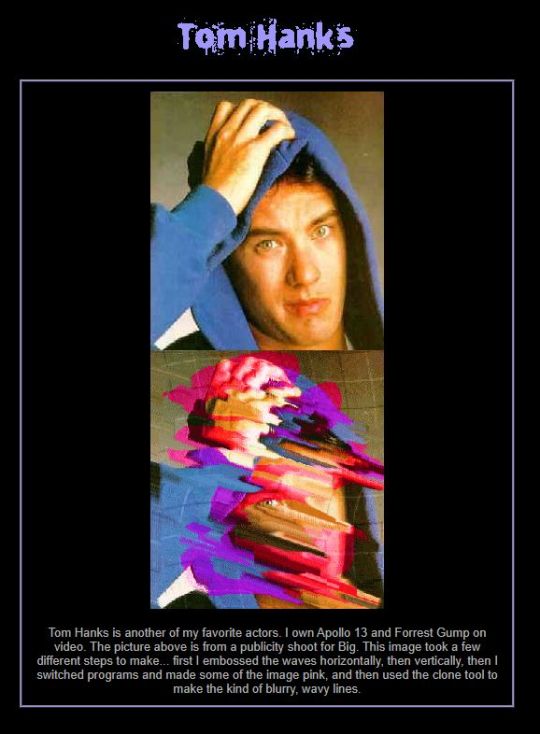




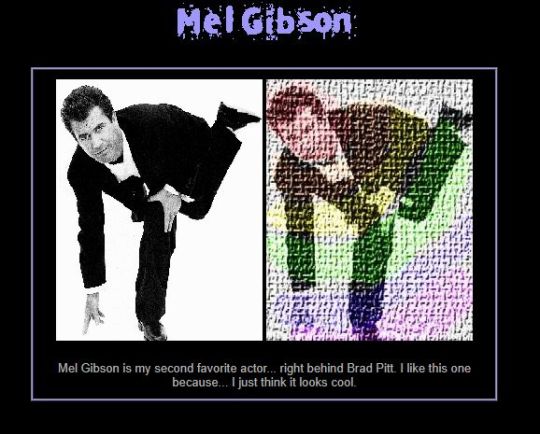
Sorry this post looks like crap/is so massive. I couldn’t bring myself to leave any of the pure genius out.
#Jenny McCarthy#Gillian Anderson#90s#Ani diFranco#Brad Pitt#geocities#Mel Gibson#David Duchovny#Jodie Foster#Tom Cruise#Kevin Costner#Rene Russo#Denzel Washington#Tom Hanks#Kirsten Dunst#personal page#fan page#CelebArt#where soho meets hollywood#music#fanart#old web#old internet#webcore#rosie o'donnell#celebrities
38 notes
·
View notes
Photo
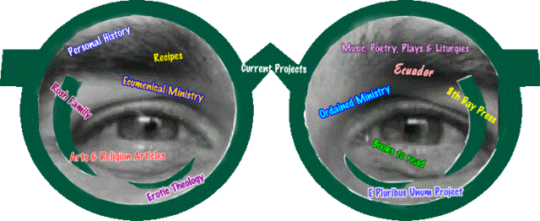
So you wanna get inside the head of this guy?
O.K. This way in
12 notes
·
View notes
Text

I have spent all morning trying to find this site, between combing the geocities tumblr archive blog and then going through the Wayback machine.....but then I found it, and the midi I was looking for. <3
Wayback link : https://web.archive.org/web/20090624010705/http://geocities.com/SoHo/Gallery/1162/
#hotaru's planet of burning silence#i grew up going to this website#i remembered the soho/gallery part#thought the number was 1172 but i was *damn* close#i remember downloading Another Story from this website
0 notes
Text
Evolution of Digital Art
The history of web based art communities goes back to the advent of the internet and is full of highs and lows. Art centric websites actually existed since before digital images were even being uploaded to the web, and in fact even before web browsers were publicly available. On the early internet, text only bulletin board systems (BBS) emerged as a way for people with similar interests to communicate online. “The Thing,” created by Wolfgang Staehle in 1991, was one such BBS. The board was focused on art and art criticism, and while there were still no actual images on the internet to share, members could openly post messages discussing art and culture, as well as share announcements for upcoming art gallery events. Along with BBS’s, Usenet newsgroups and listserves were common forms of interaction over the web. Below is an image of the original version of “The Thing” displayed in the New Museum in NYC.

In 1992, the first photo was uploaded to the web by Tim Berners-Lee, who was also one of the folks who invented the internet. The image was of “Les Horribles Cernettes,” an all female comedy band, which can be seen below. In 1993, the first web browser that could display images and text simultaneously in the same window was released under the name “Mosaic.” Prior to its release, images had to be displayed in a separate window from text. Mosaic popularized the world wide web and is attributed with leading to the internet boom of the 1990’s. The release of this browser also made the creation of all of the following art sharing websites possible.

The first version of GeoCities was launched in 1994 by David Bohnett and John Rezner. GeoCities allowed users to easily create their own web pages and place them into categories according to their content (called cities and named after real cities, hence the name of the site). The cities for topics of art were SoHo and Lofts for visual arts and writing, Broadway for theatre and performing arts, and a variety of cities for different genres of music. Using GeoCities, users could make a personalized page to showcase their art and, using the cities feature, both share their page and find the pages of other artists. GeoCities required some web design knowledge to get the most out of it (basic HTML was probably sufficient for most users, though). A similar web hosting service, Angelfire, launched in 1996. GeoCities shut down in late 2009 (2019 in Japan), while Anglefire is still around.
Early dedicated art sharing sites included Rhizome, which was established in 1996 as a digital art community and is not only still active but is an affiliate of the New Museum in NYC, and Wet Canvas in 1998. Wet Canvas is formatted as a standard forum site with various content channels and subforums for sharing and discussing different forms of art and currently has over one million members. The drawback of this kind of site is that users must make individual threads to share content and several layers of links must be navigated to reach the threads, which must be individually opened before being able to see any images. Individuals unfamiliar with this type of forum may find the interface difficult to navigate. The benefit to this format is that the poster’s art is displayed isolated from other pieces in a message thread that allows other users to directly post responses.
One of the most well known hosting sites for art, DeviantArt, was launched in the year 2000. Initially called “Deliciously Deviant Deviant Art!” the site was focused on art made for customizing (or “deviating,” thus the name) a user’s desktop such as wallpapers and skins for browsers and media players. This initial focus on digital visual customization may be what led to the site’s more immediately engaging design with even early versions of the site displaying thumbnails of recent submissions and a daily list of curated favorites. Each user also received their own profile page, which lacked many options for customization, but placed all of a user’s submissions into a gallery that made browsing artwork quick and simple. Each user page and even each individual submission had a shout board that allowed users to talk to each other or leave praise or criticism for artists. User pages also contained a section for showing submissions that the user had added to their “favorites.”
The visual nature of the site was naturally a benefit to getting more eyes on submitted artwork faster, and the favorites galleries helped works gain popularity even more quickly. If DeviantArt has one major drawback, it is that outside of a user’s gallery, they have no control over what other submissions may appear alongside their own. As the site caters to all ages, quality varies widely, as does the content of the submissions. While outright pornography is banned, risque material may appear unfiltered on the home page.
In 1964, Marshall McLuhan coined the phrase, “the medium is the message.” This means that the way in which media is delivered, the medium, becomes part of the message of the content and is just as important if not more so than the actual meaning or message of the media. Compare the presentation of a work of art in a museum to how it may be displayed on an art sharing website such as DeviantArt. In a museum, each piece is generally displayed in isolated, centered vertically at eye level, and presented in ideal lighting conditions. The works in a collection are curated and typically arranged by a theme, such as period, style, or artist. Access to the works is gate kept by ticket prices, hours of operation, and geographical location. A work’s presentation within a museum or physical gallery at all immediately elevates its value. Below is Rembrandt’s “The Night Watch” on display in the Rijksmuseum in Amsterdam as an example.
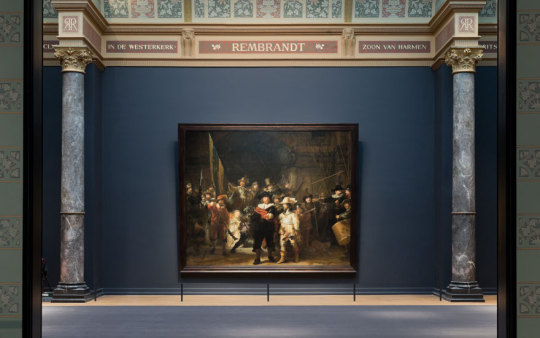
In contrast, imagine browsing an art hosting or social media site’s most recent images. Rembrandt is displayed surrounded on all sides by anime fanart, photos of food, screenshots, and women in bathing suits. Below is a screenshot of DeviantArt’s homepage, modified by me to illustrate this point. All of these are displayed at the same size and delivered as having equal value by the formatting of the site. The Rembrandt may still catch the eye, but the medium of delivery affects the viewer’s perception of the quality of the painting. “May” is also a keyword in this context, because the sheer volume of submissions on screen that become replaced with every reload of the home page make it easy for works to become lost in the sea of art.

This effect of digital sharing sites on the perceived quality of art has also had an effect on their monetary value. The aforementioned abundance of artists on these platforms has similarly driven prices down. A work hosted in a gallery may have a listed price of hundreds of dollars; on a site such as DeviantArt, it’s possible to commission a piece of custom art of the same level of quality often for under a hundred (not accounting for the cost of shipping in the case of a physical piece, for in the digital age a consumer could commission an artist from halfway across the world). This effectively creates a gig economy for artists in which they must attract the attention of consumers amid a massive supply of other options and set their prices in accordance with what others charge to keep customers from choosing another artist of comparable quality offering services at a lower price.
However, it seems in general that the art market has been moving more towards e-commerce than brick and mortar establishments. According to a study commissioned by Invaluable, 22.7% of art consumers found their purchases through art sharing sites or social media, versus 20% via galleries and about 16% via galleries. This is especially true for younger generations; between 33 and 44% of millennials (variant on age) reported discovering new art through some form of social media. Forbes reports that in-person art sales went down in 2015 after reaching an all time high in 2014, while online sales rose greatly. They projected that this year, the market for art sales online will reach $9.58 billion. Below is a graph I made of actual online art sales from 2013 to 2018, along with Forbes’ projected value for 2020.
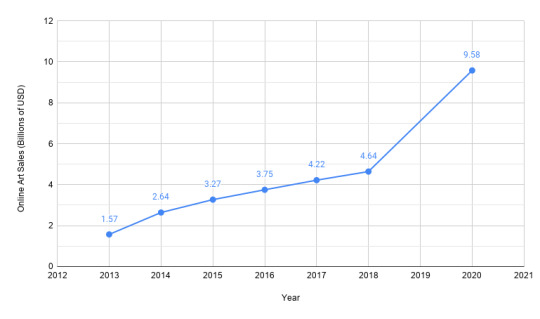
The most significant shift for the production and consumption of art online in the last decade has been the website Patreon, which was founded in 2013 by Sam Yam and Jack Conte. It is a platform that allows artists and other creators to offer a subscription based content delivery service. The creator earns monthly or by-upload income from their subscribers, or “patrons,” effectively allowing them to make the content that they want and get paid to do it by individuals who appreciate what they produce. The site offers subscription tiers that the artist may enable to offer patrons rewards based on the amount of their monetary contribution. Some artists choose to use this feature to provide personalized art to their patrons, while others allow full access to their content for subscriptions of any value.
0 notes
Text



Found at /SoHo/Veranda/2200/ on Geocities.
102 notes
·
View notes
Text

Found at /SoHo/Exhibit/2817/ on Geocities.
77 notes
·
View notes
Photo

#old web#geocities#90s aesthetic#old web aesthetic#webcore#1667 on oocities#in the SOHO art zone#why are you so angry budman....
9 notes
·
View notes
Photo
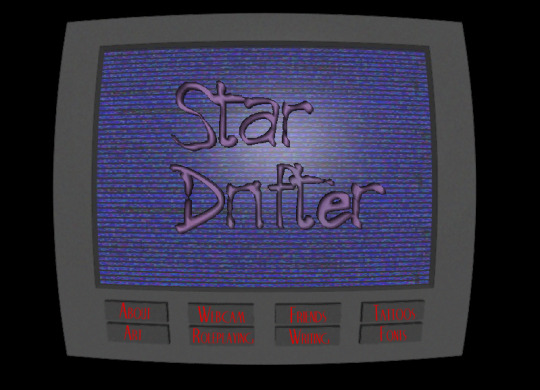
5 notes
·
View notes
Photo
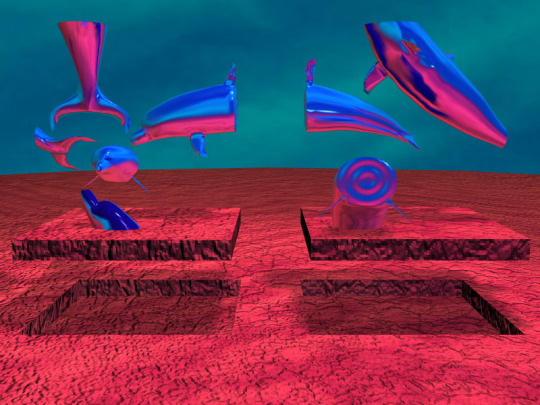
Dolphins in Metaspace Created with 3D Studio MAX. Photoshop 4.0 was used for texture creation. I constructed the dolphin mesh out of patch primitives.
121 notes
·
View notes
Photo

Come on in... pull up a chair, grab a cup and a cookie or two. Welcome to my mind... You'll find a lot of interests here from my Methos obsession to general fantasy to whimsical poetry.
13 notes
·
View notes
